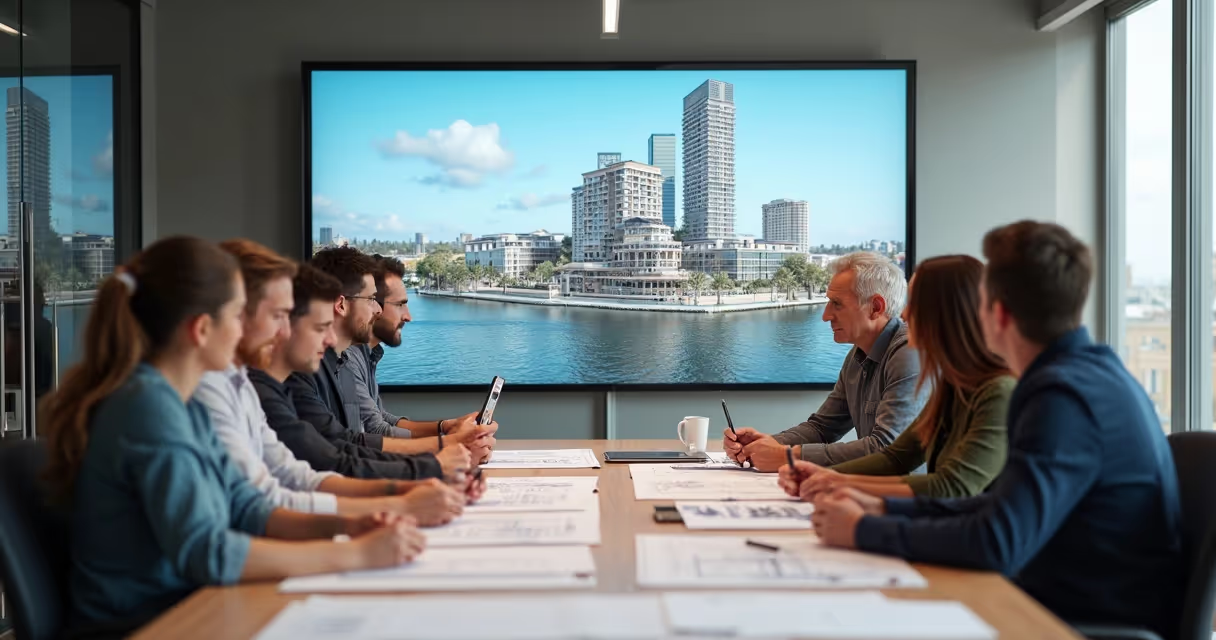Real estate marketing isn't just about placing a “For Sale” sign on the front of a plot of land and cheering for someone to show up. If that were the case, everyone would be a millionaire selling houses, wouldn't they? The truth is that the real estate market has changed dramatically, and those who still think that a colorful pamphlet will solve all problems are living in the era of digital caves. Now, digital strategies make perfect sense, especially for architects, engineers, interior designers, and companies that want to sell projects, win clients, and stand out. And yes, Redraw is here to transform your visual marketing with real artificial intelligence, no three-day renders! If you want to know how to prepare your business for 2025, read on and discover the twelve strategies that will redefine your online positioning. And of course, then try Redraw to take your images (and sales) to the next level!
Have you ever tried to explain to a client what that integrated room filled with natural light would be like, but noticed that they shook their heads like someone who says “I understand” and, in the background, did not see anything? So, you've already felt the importance of good marketing in the real estate sector. It's not enough just to know how to plan architectural projects: you need to know how to sell them. This means creating clear, visual, and objective communication, in addition to using digital resources to reach the right audience. In the end, real estate marketing involves everything, from the first contact to the closing of contracts.
In fact, mastering these strategies is a matter of survival for architects and designers who don't want to be left behind. After all, consumers in 2025 already take a virtual tour before they even leave home. And hastily rendered a project or low-quality images are becoming less and less tolerable. This is where Redraw makes all the difference, but let's get there...
Those who don't show up simply don't exist.
If there is an important frontier for the sector, it is called artificial intelligence. Remember those renders that took hours, sometimes days, and crashed computers? Well, now they're ready in seconds, right in the browser and with jaw-dropping quality. This evolution reduced the time spent on repetitive tasks and allowed professionals to dedicate more energy to creating, personalizing communication, and customer service.
Process automation, such as instant generation of realistic images and animated videos, is already a reality. AI-based tools, such as Redraw, are rewriting the rules and making marketing for real estate agents much more visual and effective. This is because clients' decision-making is much faster and more assertive when they see the project exactly as it will be.

It sounds like magic, but it's technology. Get ready, because everything that seemed complicated and time-consuming will become a thing of the past, along with the old sales sign.
Do you want to make a difference in marketing in the real estate sector? I separated the seven digital strategies that cannot be missing in your planning. Remember that creativity and visual quality must always go hand in hand. Let's check:
Do you know the incredible portfolio that you spent hours fine-tuning in SketchUp, Revit, or AutoCAD? Well, if it's not optimized for searches, maybe no one (other than your mother) will find it. SEO is the rice bean of digital real estate marketing: working on keywords such as “sustainable projects”, “house with pool” or “small apartment renovation” in titles, descriptions and images is essential.
In fact, realistic renders and animated videos made on platforms like Redraw increase not only the time visitors spend on your site, but also the chances of them becoming a lead.
If you think that just posting a photo of the finished project will do the trick, think again. Social networks, especially visual ones, are powerful storefronts. But here's the trick: it's not enough just quantity, it's quality and context that make the difference. Invest time and energy in:
Instagram, for example, values short videos and impressive images. If you render your projects with high quality on Redraw, you can be sure that you will attract attention (and maybe even tear off that “Wow!” two followers).

Yes, good old email still works miracles, if it's used well. The trick is to personalize, there's no use sending the same message to everyone. And never, ever send a bunch of heavy attachments: prefer links to online renders, short videos, and optimized images. Practical tips:
Customers want to see solutions, not spam. Take the opportunity to show how fast rendering with AI streamlines your process and delivers more value.
Nobody can stand those texts full of blah-blah-blah that don't explain anything. Producing technical but accessible content is still rare in marketing for real estate agencies and architectural firms. And that can be your differential. Suggestions:
In addition, including images comparing technical solutions with realistic renders helps in understanding the client. Do this and see how much more engaged your leads are!
Those who work in isolation are, in practice, digitally invisible. Partnerships, whether with construction companies, real estate companies, furniture suppliers or technology companies, expand the reach and give clients more confidence. Examples of action:
When everyone wins, your projects travel faster and with more authority.

Have you ever tried to present a real estate project with only floor plans and models? It sounds like a boring geometry class. Now, virtual tours with the support of artificial intelligence allow the client to “walk” around the property, change colors, furniture, styles and even simulate lighting. The best part: it can be done right from the browser, without all that drama of downloading large files. If rendering was already boring and complicated, Redraw does it in seconds, making the process quick and didactic, even for those who don't understand anything about architecture.
Do you know that digital influencer who talks to construction companies, other architects, designers or suppliers? In digital strategies for 2025, the B2B (business to business) focus is gaining strength. Showing results, sharing success stories, and participating in online events in the area generates qualified visibility. And honestly, nothing better than another professional recommending your work. If it shows your incredible realistic images and renders, even better!
In the project market, reputation sells more than pamphlets.
Have you ever wondered if it's worth investing more in digital stocks than in classic ones, like that good old banner on the façade? The answer lies in the data: almost 95% of property searches start online. The client wants to research prices, compare projects and view environments before even visiting the place.
In other words, it's not the end of the brochures, but each real invested in digital strategies offers much more return and data to adjust campaigns, refine the discourse and hit (almost) the fly.
If you don't like numbers, it might be time to rethink your strategy. Measuring results is what separates professionals from amateurs in digital real estate marketing. KPIs (key performance indicators) don't have to be scary, but ignoring them is asking to throw money away. Here are some of the key KPIs to keep an eye on:
The more detailed the follow-up, the better the adjustment of your campaigns. It's boring at first, but once you get the hang of it, you start to like the numbers going up, I promise.
If you want to ride the next wave, you need to know where it's going to break, right? Then, here are the strong trends in digital strategies for the real estate market in 2025:
Technology, especially platforms such as Redraw, is already part of this scenario, allowing the delivery of high-quality material in record time and at an affordable cost.
Yes, everyone has slipped into any of these, maybe even you:
Its audience is increasingly informed and impatient. If you get the basics wrong, don't expect a second chance. The secret? Dedication, time and, of course, state-of-the-art technology to deliver what the customer expects (or even more).
The good news is that you don't have to do everything yourself, using pencils, paper, and hope. There are several platforms that automate tasks, improve your communication, organize contacts and, most importantly, get your renders ready quickly. Redraw, for example, is perfect for those who use SketchUp, Promob or Revit and want to gain agility without sacrificing visual quality.
The secret lies in choosing those that really bring back. Sometimes less is more. And if each tool integrates well with your workflow, the result appears painlessly.

Digital real estate marketing is about building an online presence with a focus on conquering and delighting clients. This includes optimizing portfolio with SEO, investing in realistic images, using social networks to showcase projects (not just to “make it beautiful”), and creating useful content, such as tips, videos, and tutorials. Paid ads help, but if you don't present visually stunning projects, you could end up wasting investment.
Without well-defined strategies, no project reaches its ideal audience. Marketing transforms architects, engineers, and designers into references for those who are truly willing to hire. It brings customers closer together, streamlines decisions and, in the end, makes the phone ring. For complex projects, with a lot of details, good visual communication (and the use of AI such as Redraw) can be the difference between closing a contract or not.
Among the best strategies are: portfolios optimized for search, technical content marketing, intelligent use of visual social networks, strategic partnerships, virtual tours with AI support, segmented email, and B2B influence. And of course, constantly invest in high-quality images, whether for a simple Instagram or for the presentation that closes the contract. Mixing it all in an authentic way usually brings great results.
Start by understanding your audience's questions and wishes. Show the project step by step, explain creative decisions, share challenges and solutions with high-definition images. Guides, explanatory videos, case studies, and backstage work great. Realistic renders made with AI make communication even more visual and easy to understand, attracting curious people (and future customers!) closer to your work.
Social networks work like an active showcase: post project photos, short videos showing the process, before and after carousels, stories with everyday curiosities, and answer questions in the comments. Focus on visual quality and take advantage of features such as polls, lives, and targeted ads. Those who interact on the networks will first remember their name when doing a project.
The investment varies depending on the size of the office, level of automation, and focus of the campaigns. You can start by investing only time, with quality organic content. But to grow fast, paid ads, professional renders, and routine automation end up being inevitable and worth every penny. Platforms like Redraw offer affordable plans, democratizing access to cutting-edge technology.
Track indicators such as conversion rate (visitors who saw customers), engagement on social networks, email marketing open rate, time spent on the portfolio, and the origin of the leads. There are free and paid platforms to unify this information, making it possible to adjust the strategy almost in real time, and avoid wasted investments or misdirected efforts.
SEO is the “invisible showcase” that makes your portfolio and projects appear on Google when someone searches for keywords from your universe. Optimizing titles, descriptions, images, and texts with terms searched by clients (such as “residential project 2025”, for example) increases reach and brings more qualified leads. Ignoring SEO, today, is like setting up the dream store in the top basement of a mall without direction signs.
Now it's clear: modern real estate marketing is not a recipe for cake, but rather a set of strategic actions that connect architecture, design, technology and, above all, results. The key lies in uniting creativity, automation, data, and impactful images. If you were waiting for a signal to evolve or revolutionize your digital presence, that signal is now.
Don't just sell projects, create unforgettable experiences.
Do you want to transform your images, accelerate the closing of proposals and mark your name among the best professionals in the sector? Try Redraw and see how AI can take your visual marketing to the next level. Because, let's face it, those who still rely on old renders and dull presentations run the real risk of being forgotten before 2025 even ends.